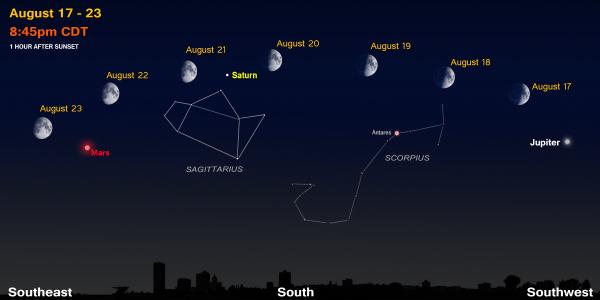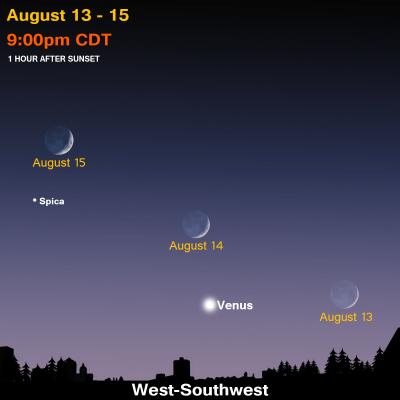Cosmic Curiosities
“I'll toss my coins in the fountain
Look for clovers in grassy lawns
Search for shooting stars in the night
Cross my fingers and dream on.”
- Tracy Chapman, American Singer
Popular Perseids
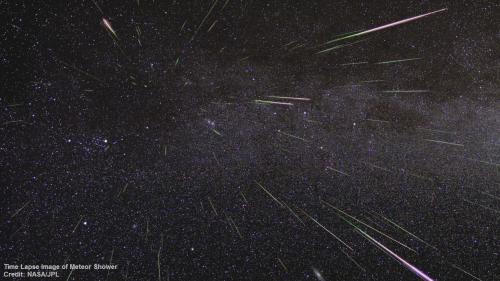
The Perseids -- the mid-August flurry of “falling stars” -- is the most watched meteor shower of the year. Its popularity stems from two factors: Timing and abundance. One warning, though: If you want to see more shooting stars, you have to get up early.
Timing
This rain of meteors from the constellation Perseus occurs in August, a warm month here in the northern hemisphere. At almost two months after the summer solstice, the nights are getting noticeably longer. This mean there’s more time for stargazing and a darker sky. Add all this up and it’s a perfect time to get away from city lights, lie on a blanket, look up, and wait patiently for streaks of light to dart across the heavens. Just remember to bring some bug spray!
The Perseids do not top the list as the best meteor shower. The Geminids in December are slightly more frequent. Also, on rare occasions, the Leonids in November and the Quadrantids in January can produce a more spectacular show. But these are all cold months and it can be uncomfortable to meteor gaze with the drop in temperature. Plus, these months are statistically cloudier than August.
This year, the Perseid meteor shower will peak on the nights of August 11-13, but the best bet for more meteors is around 3:00 a.m. until dawn on August 13 — a very early Monday morning.
Car Analogy
Okay, 3:00 a.m. is not the best time for most people. So why should you get up so early—or stay up incredibly late—to see the most meteors?
Try this analogy: Think of planet Earth as a car. The atmosphere is now your car’s windshield. They are both very helpful and protective. Now imagine you’re barreling down the highway in your cosmic car. It’s a muggy, buggy night. The insects are the meteoroids — teeny rock grains left over from a comet.
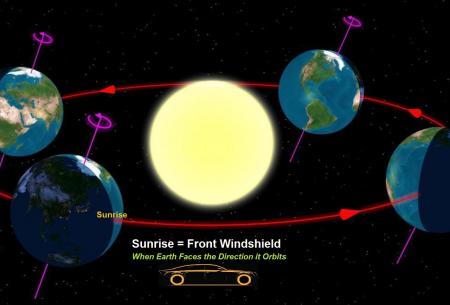 Your car is going quickly, so there is no way to avoid the numerous collisions with all the bugs. Soon, splats start smearing all across your windshield. That’s just like a meteor shower! These bug splats parallel the Earth running into all the meteoroids. When the meteoroids burn up in the atmosphere, they become meteors. It’s the friction of the tiny rocks rubbing against all the air molecules.
Your car is going quickly, so there is no way to avoid the numerous collisions with all the bugs. Soon, splats start smearing all across your windshield. That’s just like a meteor shower! These bug splats parallel the Earth running into all the meteoroids. When the meteoroids burn up in the atmosphere, they become meteors. It’s the friction of the tiny rocks rubbing against all the air molecules.
If you stare at all the dead insects on your windshield, you will surely notice there are more on the front. It’s the same deal with Perseid meteors. The Earth's front windshield is the early morning sky. This means that as the Sun rises, we are facing the direction the Earth is moving in its orbit. Our planet is plowing into the meteoroid debris head-on, just like bugs plowing into your front windshield. This is why it's usually best to look for Perseids just before dawn. The 3:00 a.m. time is somewhat arbitrary. We want you to see lots of meteors but we also want you to get some sleep!
Abundance
A high rate of meteors (70 to 90 per hour are predicted for 2018) is another factor in Perseid popularity. My guess is if you get away from streetlights far enough to see a glimpse of the Milky Way, you should easily see 50 meteors per hour, but hopefully more! If you stay in the city, you will be able to spot the brighter ones, but your total number will be much lower.
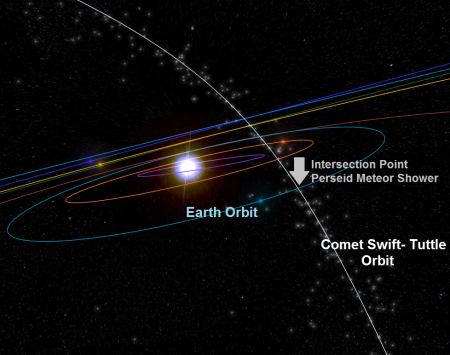 The reason for a higher rate this year is the absence of our bright nightlight -- the Moon. Though gorgeous of course, a bright Moon acts just like a bright street light. A thin crescent Moon will set quickly after the Sun from August 11-13.
The reason for a higher rate this year is the absence of our bright nightlight -- the Moon. Though gorgeous of course, a bright Moon acts just like a bright street light. A thin crescent Moon will set quickly after the Sun from August 11-13.
Every year, the Earth zooms right through a bunch of tiny dust grains from ancient comets. This debris spreads out over the many years so there’s not a perfectly precise time for a meteor shower.
In August, our planet plows through the dust grains left from Comet Swift-Tuttle. A few of these tiny rocks might be a bit bigger, maybe the size of a pea or grape. They vaporize as they move through our atmosphere at speeds of over 20 miles per second. This creates the brilliant, breathtaking streaks across the night sky. The Perseids emanate from the constellation Perseus. It rises in the northeast around midnight and is high above you about 5:00 a.m. CDT.
Sirius Stories
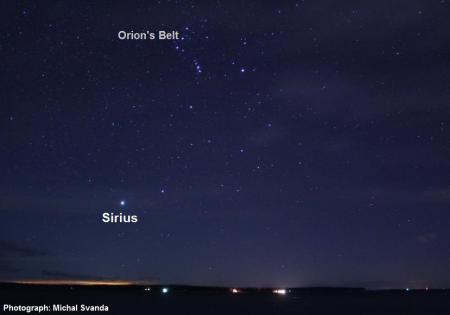 August marks the return of Sirius, the brightest star in the night sky. An early-bird stargazer will see Sirius rising just before the Sun. Sirius is located in the constellation Canis Major, one of Orion’s hunting dogs. Look for Orion’s belt in the eastern morning sky and simply follow the three stars straight down to Sirius.
August marks the return of Sirius, the brightest star in the night sky. An early-bird stargazer will see Sirius rising just before the Sun. Sirius is located in the constellation Canis Major, one of Orion’s hunting dogs. Look for Orion’s belt in the eastern morning sky and simply follow the three stars straight down to Sirius.
Story #1: The Dog Days of Summer
Many have heard the expression “the dog days of summer.” It refers to the hot, humid days of August. No one is sure where this saying came from. Since we are unsure of the origin, explanations are created to fill the void. One obvious reason is that dogs are constantly seeking shade because of the intense, prolonged heat, and so somebody somewhere invented this catchy phrase.
Another tale has to do with the dog-star Sirius. Around late July and early August, Sirius lines up with the Sun. By mid-August the Earth has moved in its orbit and we finally start to see it rising just before dawn. Long ago, many people across the globe have noticed the alignment of the Sun and Sirius. Is it possible someone believed that the extra heat from the dog-star, lining up with the Sun, is the reason August gets so hot, then this person coined the phrase “dog days of summer” and it stuck?
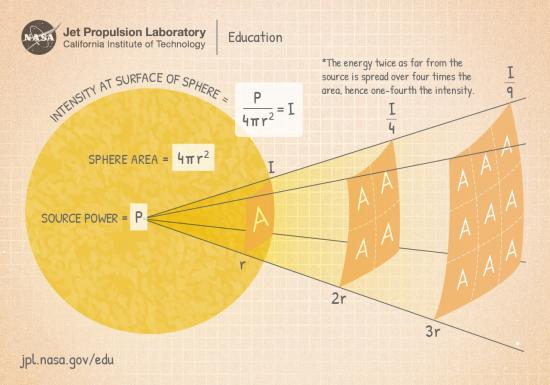 It’s very unlikely. We never feel heat from a star. Technically, there is heat from the stars, but it is a negligible factor in the Earth’s climate. Still, long ago, astronomers thought the stars were much closer than we know today. The Sun was said to be 4 million miles away instead of the 93 million miles we know today. All stars were reasoned to be located in a crystalline sphere at 73 million miles away. That’s much closer than the true distance. Sirius is actually over eight light years away, or about 50 trillion miles! That’s almost a million times further than the ancient peoples thought.
It’s very unlikely. We never feel heat from a star. Technically, there is heat from the stars, but it is a negligible factor in the Earth’s climate. Still, long ago, astronomers thought the stars were much closer than we know today. The Sun was said to be 4 million miles away instead of the 93 million miles we know today. All stars were reasoned to be located in a crystalline sphere at 73 million miles away. That’s much closer than the true distance. Sirius is actually over eight light years away, or about 50 trillion miles! That’s almost a million times further than the ancient peoples thought.
At this great distance, Sirius is a trillion times (a million squared) less potent than previously reasoned. This number comes from using the inverse square law of light. As light leaves a star, it spreads out in all directions. If you double the distance from a star, the amount of energy will be four times less. If you triple the distance, there’s nine times less energy.
No matter who coined the idiom, August days can get long and hot here in the northern hemisphere and “the dog days of summer” works just fine.
_0.jpg) Story #2: The Pup
Story #2: The Pup
Sirius has a companion star. It’s a very small white dwarf star near the end of its life. Together they are known as Sirius A and Sirius B, a binary star system. Since Sirius A is the dog-star, sometimes its small partner is called the “pup.”
Sirius B is 10,000 times dimmer than Sirius A. This means we can’t see it in the night sky, even with most backyard telescopes. Over 200 million years ago, the star was younger, bigger, and brighter than its partner. But stars evolve, or more basically, they run out of hydrogen fuel. In about 5 billion years, our Sun will become a white dwarf star.
The story of the “pup” starts with the star’s discovery way back in 1862. Somehow, the Dogon people of Africa (present day Mali) knew about this companion star before it was found — without using a telescope. They told a researcher in 1938 about this companion star of Sirius, even noting its 50 year orbital period. They also knew about Saturn’s rings and the moons of Jupiter, both of which can’t be seen with the human eye. The story gets stretched when some surmise that alien intelligent beings from the Sirius star system somehow communicated this astronomical information to the Dogons. How else could they know?
Well, one possible answer is simply the researcher misinterpreted the Dogon information about Sirius. There could have been a miscommunication with their language.
Another explanation is that a transfer of astronomy information to the Dogons took place after the discovery of Sirius B. One example cited is a French total solar eclipse expedition to the west Central Africa in 1893. The eager scientists might have passed on all kinds of astronomy discoveries to the Dogons, including the fact that Sirius had a companion star you could not see with human eyes.
These two possibilities are much more probable than any alien visit, though it makes the story a little less exciting.
Sky Sights
Mars peaked in brightness on July 31, but August still is perfect to spot an extremely bright red planet. Plus, Mars rises early each night. On August 1, look for Mars rising in the southeast about 8:30 p.m. CDT. On August 31, the fourth rock from the Sun rises about 6:15 p.m. CDT. The Moon passes by on the nights of August 22-23.
Jupiter shines bright in the southwest in the constellation Libra. See if you can spot the fairly bright “Zubee” stars, properly known as Zubenelgenubi and Zubeneschmali. Jupiter sets earlier as August nights progress. At month’s start, the king planet sets around midnight. By the end of August, it sinks below the horizon about 10:00 p.m. CDT.
Don’t overlook Saturn this month. It shines steadily above the teapot of Sagittarius. The Moon can be seen near the ring world on August 20-21.
Brilliant Venus hangs on, sinking a little lower each night in the west-southwest sky. The Moon makes a great pair with the brightest planet on August 13-14. Observe them soon after dusk in the constellation Leo the Lion.
Mercury rises before the Sun in the east-northeast sky, but it will be very difficult to see.
Star Map
Download the August Star Map. >>
Sign Up
Receive this newsletter via email by subscribing here! >>
See the Universe through a telescope! Join one of the Milwaukee-area astronomy clubs and spot craters on the Moon, the rings of Saturn, the moons of Jupiter, and much more.
 Follow Bob on Twitter @MPMPlanetarium
Follow Bob on Twitter @MPMPlanetarium


